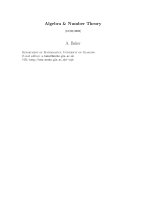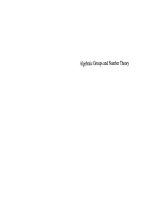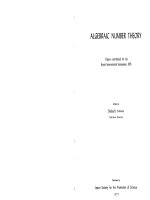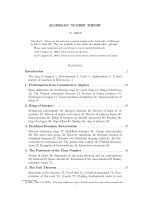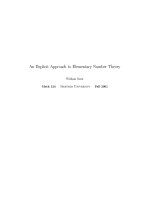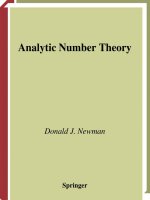- Trang chủ >>
- Sư phạm >>
- Sư phạm toán
Number theory róbert freud, edit gyarmati
Bạn đang xem bản rút gọn của tài liệu. Xem và tải ngay bản đầy đủ của tài liệu tại đây (4.68 MB, 563 trang )
48
Number
Theory
Róbert Freud
Edit Gyarmati
Number
Theory
UNDERGRADUATE TEXTS • 48
Number
Theory
Róbert Freud
Edit Gyarmati
EDITORIAL COMMITTEE
Gerald B. Folland (Chair) Steven J. Miller
Jamie Pommersheim Maria Cristina Pereyra
2010 Mathematics Subject Classification. Primary 11-00,
11-01, 11A05, 11A07, 11A25, 11A41.
For additional information and updates on this book, visit
www.ams.org/bookpages/amstext-48
Library of Congress Cataloging-in-Publication Data
Names: Freud, Ro´bert, author.
Title: Number theory / Ro´bert Freud, Edit Gyarmati.
Description: Providence, Rhode Island: American Mathematical Society, [2020] | Series: Pure and
applied undergraduate texts, 1943-9334; volume 48 | Includes bibliographical references and
index.
Identifiers: LCCN 2020014015 | ISBN 9781470452759 (paperback) | ISBN 9781470456917 (ebook)
Subjects: LCSH: Number theory. | AMS: Number theory – General reference works (handbooks,
dictionaries, bibliographies, etc.). | Number theory – Instructional exposition (textbooks,
tutorial papers, etc.). | Number theory – Elementary number theory – Multiplicative structure;
Euclidean algorithm; greatest common divisors. | Number theory – Elementary number theory
– Congruences; primitive roots; residue systems. | Number theory – Elementary number theory
– Arithmetic functions; related numbers; inversion formulas. | Number theory – Elementary
number theory – Primes.
Classification: LCC QA241 .F74 2020 | DDC 512.7–dc23
LC record available at />
Copying and reprinting. Individual readers of this publication, and nonprofit libraries acting
for them, are permitted to make fair use of the material, such as to copy select pages for use
in teaching or research. Permission is granted to quote brief passages from this publication in
reviews, provided the customary acknowledgment of the source is given.
Republication, systematic copying, or multiple reproduction of any material in this publication
is permitted only under license from the American Mathematical Society. Requests for permission
to reuse portions of AMS publication content are handled by the Copyright Clearance Center. For
more information, please visit www.ams.org/publications/pubpermissions.
Send requests for translation rights and licensed reprints to
c 2020 by the authors. All rights reserved.
Printed in the United States of America.
∞ The paper used in this book is acid-free and falls within the guidelines
established to ensure permanence and durability.
Visit the AMS home page at />
10 9 8 7 6 5 4 3 2 1 25 24 23 22 21 20
Contents
Introduction 1
Structure of the book 1
Exercises 2
Short overview of the individual chapters 2
Technical details 4
Commemoration 4
Acknowledgements 5
Chapter 1. Basic Notions 7
1.1. Divisibility 7
Exercises 1.1 9
1.2. Division Algorithm 11
Exercises 1.2 13
1.3. Greatest Common Divisor 15
Exercises 1.3 19
1.4. Irreducible and Prime Numbers 21
Exercises 1.4 23
1.5. The Fundamental Theorem of Arithmetic 24
Exercises 1.5 27
1.6. Standard Form 28
Exercises 1.6 33
Chapter 2. Congruences 37
2.1. Elementary Properties 37
Exercises 2.1 40
v
vi Contents
2.2. Residue Systems and Residue Classes 41
Exercises 2.2 44
2.3. Euler’s Function 𝜑 46
Exercises 2.3 49
2.4. The Euler–Fermat Theorem 50
Exercises 2.4 51
2.5. Linear Congruences 52
Exercises 2.5 57
2.6. Simultaneous Systems of Congruences 58
Exercises 2.6 64
2.7. Wilson’s Theorem 66
Exercises 2.7 67
2.8. Operations with Residue Classes 68
Exercises 2.8 70
Chapter 3. Congruences of Higher Degree 73
3.1. Number of Solutions and Reduction 73
Exercises 3.1 75
3.2. Order 76
Exercises 3.2 78
3.3. Primitive Roots 80
Exercises 3.3 84
3.4. Discrete Logarithm (Index) 86
Exercises 3.4 87
3.5. Binomial Congruences 88
Exercises 3.5 90
3.6. Chevalley’s Theorem, Kőnig–Rados Theorem 91
Exercises 3.6 95
3.7. Congruences with Prime Power Moduli 96
Exercises 3.7 98
Chapter 4. Legendre and Jacobi Symbols 101
4.1. Quadratic Congruences 101
Exercises 4.1 103
4.2. Quadratic Reciprocity 104
Exercises 4.2 108
4.3. Jacobi Symbol 109
Exercises 4.3 111
Contents vii
Chapter 5. Prime Numbers 113
5.1. Classical Problems 113
Exercises 5.1 117
5.2. Fermat and Mersenne Primes 118
Exercises 5.2 124
5.3. Primes in Arithmetic Progressions 125
Exercises 5.3 127
5.4. How Big Is 𝜋(𝑥)? 128
Exercises 5.4 133
5.5. Gaps between Consecutive Primes 134
Exercises 5.5 139
5.6. The Sum of Reciprocals of Primes 140
Exercises 5.6 147
5.7. Primality Tests 149
Exercises 5.7 157
5.8. Cryptography 160
Exercises 5.8 163
Chapter 6. Arithmetic Functions 165
6.1. Multiplicative and Additive Functions 165
Exercises 6.1 167
6.2. Some Important Functions 170
Exercises 6.2 173
6.3. Perfect Numbers 175
Exercises 6.3 177
6.4. Behavior of 𝑑(𝑛) 178
Exercises 6.4 185
6.5. Summation and Inversion Functions 186
Exercises 6.5 189
6.6. Convolution 190
Exercises 6.6 193
6.7. Mean Value 195
Exercises 6.7 206
6.8. Characterization of Additive Functions 207
Exercises 6.8 209
Chapter 7. Diophantine Equations 211
7.1. Linear Diophantine Equation 212
Exercises 7.1 214
viii Contents
7.2. Pythagorean Triples 215
Exercises 7.2 217
7.3. Some Elementary Methods 218
Exercises 7.3 221
7.4. Gaussian Integers 223
Exercises 7.4 229
7.5. Sums of Squares 230
Exercises 7.5 235
7.6. Waring’s Problem 236
Exercises 7.6 240
7.7. Fermat’s Last Theorem 241
Exercises 7.7 249
7.8. Pell’s Equation 251
Exercises 7.8 255
7.9. Partitions 256
Exercises 7.9 261
Chapter 8. Diophantine Approximation 263
8.1. Approximation of Irrational Numbers 263
Exercises 8.1 268
8.2. Minkowski’s Theorem 270
Exercises 8.2 274
8.3. Continued Fractions 275
Exercises 8.3 280
8.4. Distribution of Fractional Parts 281
Exercises 8.4 283
Chapter 9. Algebraic and Transcendental Numbers 285
9.1. Algebraic Numbers 285
Exercises 9.1 288
9.2. Minimal Polynomial and Degree 288
Exercises 9.2 290
9.3. Operations with Algebraic Numbers 291
Exercises 9.3 294
9.4. Approximation of Algebraic Numbers 296
Exercises 9.4 300
9.5. Transcendence of 𝑒 301
Exercises 9.5 306
9.6. Algebraic Integers 306
Contents ix
Exercises 9.6 308
Chapter 10. Algebraic Number Fields 311
10.1. Field Extensions 311
Exercises 10.1 314
10.2. Simple Algebraic Extensions 315
Exercises 10.2 319
10.3. Quadratic Fields 320
Exercises 10.3 330
10.4. Norm 331
Exercises 10.4 334
10.5. Integral Basis 335
Exercises 10.5 340
Chapter 11. Ideals 341
11.1. Ideals and Factor Rings 341
Exercises 11.1 345
11.2. Elementary Connections to Number Theory 347
Exercises 11.2 350
11.3. Unique Factorization, Principal Ideal Domains, and Euclidean Rings 350
Exercises 11.3 355
11.4. Divisibility of Ideals 357
Exercises 11.4 361
11.5. Dedekind Rings 363
Exercises 11.5 372
11.6. Class Number 373
Exercises 11.6 376
Chapter 12. Combinatorial Number Theory 377
12.1. All Sums Are Distinct 377
Exercises 12.1 384
12.2. Sidon Sets 386
Exercises 12.2 393
12.3. Sumsets 394
Exercises 12.3 402
12.4. Schur’s Theorem 403
Exercises 12.4 407
12.5. Covering Congruences 408
Exercises 12.5 412
x Contents
12.6. Additive Complements 412
Exercises 12.6 418
Answers and Hints 421
A.1. Basic Notions 421
A.2. Congruences 431
A.3. Congruences of Higher Degree 442
A.4. Legendre and Jacobi Symbols 452
A.5. Prime Numbers 455
A.6. Arithmetic Functions 467
A.7. Diophantine Equations 483
A.8. Diophantine Approximation 501
A.9. Algebraic and Transcendental Numbers 505
A.10. Algebraic Number Fields 510
A.11. Ideals 516
A.12. Combinatorial Number Theory 521
Historical Notes 531
Tables 537
Primes 2–1733 538
Primes 1741–3907 539
Prime Factorization 540
Mersenne Numbers 541
Fermat Numbers 542
Index 543
Introduction
The book is intended to serve several purposes; being a
(A) Theoretical textbook for teaching number theory at universities and colleges,
mostly for majors in mathematics, applied mathematics, mathematics education,
and computer science.
(B) Collection of exercises and problems for the above audience.
(C) Handbook for those interested in more detail in some chapters of number theory
beyond the compulsory and elective courses and/or writing a thesis in this subject.
(D) Manual summarizing the most important chapters of (elementary) number the-
ory for mathematicians and mathematics teachers.
Structure of the book
To achieve the above goals, the discussion starts at an absolutely basic level and the
first two chapters are based solely on high school mathematics. This part uses elemen-
tary and non-abstract tools, and instead of overly compact reasoning, detailed expla-
nations facilitate better understanding for beginners. On the other hand, we lay stress
on presenting theorems illustrating the deeper coherence of the material and on proofs
containing nice and difficult ideas.
The subsequent chapters enter more and more deeply into the discussion of vari-
ous topics in number theory. We strive to present a wide panorama of this extremely
multi-colored world (including many old but still unsolved problems) and to discuss
many methods elaborated through many centuries to treat these questions. Where pos-
sible, the newest results of number theory are inserted. Several parts apply some results
and methods from other fields of mathematics too, mostly from (classical, linear, and
abstract) algebra, analysis, and combinatorics.
1
2 Introduction
The book is structured to systemize the material and to provide a close relation
between the individual chapters as much as possible.
As a general guideline, the notions and statements are thoroughly illuminated
from various aspects beyond the formal phrasing, they are illustrated by examples and
connections to the previous material. Their essential features are strongly emphasized
pointing out the complications and analyzing the motives for introducing a given no-
tion. Careful attention is paid to start from the concrete where possible and to proceed
towards the general only afterwards. We try to give a broad perspective about the strong
and colorful relations of number theory to other branches of mathematics.
Exercises
Each section in every chapter is followed by exercises. They serve several purposes:
some of them check the comprehension of the notions, theorems, and methods, and
give a deeper understanding; others present new examples, relations, and applications;
again others study further problems related to the topic. They often include also theo-
rems disguised as exercises revealing some interesting aspects or more remote connec-
tions not treated in the text in detail.
Exercises vary in quantity and in difficulty within fairly large limits depending on
the topic, size, and depth of the material. The hard and extra-hard exercises (in our
judgement) are marked with one and two asterisks, resp. (The difficulty of an exercise
is always relative, of course: besides the abilities, interests, and preliminary general
knowledge of the solver, it depends strongly also on the exercises already solved.)
Answers and/or some hints to nearly all exercises can be found in the chapter An-
swers and Hints. To some (mostly harder) problems detailed solutions are presented
in an online chapter available at www.ams.org/bookpages/amstext-48. These exer-
cises are marked with a letter S in the text.
The reader is advised to consult a hint or solution only if an exercise turns out to
be absolutely unmanageable, or to return to the same problem later, or to solve first
some special case of it.
It is important to unravel the message and background of an exercise, its position
and role in the mathematical environment. Also a generalization or raising new prob-
lems are very useful (even if it is not clear how to solve them).
Short overview of the individual chapters
The first two chapters are introductory, discussing the divisibility of integers, the great-
est common divisor, unique prime factorization, and elementary facts about congru-
ences. A firm mastery of this material is indispensable for understanding the later
chapters.
In Chapters 3 and 4 we continue to develop the theory of congruences.
Short overview of the individual chapters 3
Chapter 5 deals with prime numbers. This simply defined set is one of the most
mysterious objects in mathematics. We discuss Euclid’s theorems (more than two thou-
sand years old) and the sensational discovery of the last decades, the public key cryp-
tosystems based on the contrast of quick primality testing and awfully slow prime fac-
torization. In this chapter we rely both on previously acquired knowledge in number
theory and the results and methods of elementary analysis.
In Chapter 6 we study arithmetic functions. Besides investigating some concrete
important functions, we present several general constructions and applications.
Chapter 7 is about Diophantine equations. After discussing the simplest types (lin-
ear equations, Pythagorean triples), we look at Waring’s problem and prove the special
cases of Fermat’s Last Theorem for exponents three and four. The methods require
the theory of Gaussian and Eulerian integers that will be generalized in Chapters 10
and 11.
The topic of Chapter 8 is Diophantine approximation that is important for certain
applications. We briefly consider also the connection with the geometry of numbers
and continued fractions.
Chapters 9–11 are closely related to each other. The basic properties of algebraic
numbers and algebraic integers from Chapter 9 are essential for understanding the next
two chapters. Chapter 10 studies field extensions, focusing on the arithmetic properties
of algebraic integers in a simple extension of the rational field by an algebraic number.
Here, an intensive use is made of the notions and theorems of elementary linear al-
gebra. Finally, in Chapter 11 the arithmetic aspects of ideals are investigated. On the
one hand, ideals constitute a fine tool for exhibiting some necessary and sufficient, or
useful sufficient, conditions for the validity of unique prime factorization in general
rings, and on the other hand, the validity of unique prime factorization for ideals of
algebraic integers (though in general not for the algebraic integers themselves) plays
an important role in studying algebraic number fields.
In Chapter 12 several interesting problems from combinatorial number theory are
presented. Some of these can be discussed even at a high school study circle, whereas
others require deeper methods from various branches of mathematics. We hope that
the selection gives an idea also about the fundamental role of Paul Erdős in the progress
of this field with thrilling questions and ingenious proofs.
Throughout the text, we often refer to interesting aspects of the history of number
theory and this purpose is served also by the short Historical Notes at the end of the
book.
As is clear also from the above description, the different subfields of number the-
ory are closely interrelated to each other and to other branches of mathematics. This
causes a serious difficulty since, on the one hand, it is important to emphasize this
tight connection during the discussion of the individual topics, but, on the other hand,
it is desirable that every chapter be self-contained and complete. We tried to achieve a
balance that makes it possible to get a gradually growing full picture of a mathematical
field rich in problems and ideas for continuous readers, but allows those who just pick
a few chapters to acquire interesting, substantial, and useful knowledge.
4 Introduction
Technical details
The chapters are divided into sections. Definitions, theorems, and formulas are num-
bered as 𝑘.𝑚.𝑛 where 𝑘 refers to the chapter, 𝑚 to the section, and 𝑛 is the serial num-
ber within the given section. Definitions and theorems have a common list, thus, for
example, Definition 6.2.1 is followed by Theorem 6.2.2. Examples, exercises, etc. are
numbered with a single number restarting in each section. The statement of a defini-
tion or theorem is closed by a ♣ sign and the end of a proof is denoted by .
The search for notations, notions, and theorems can be facilitated by the very de-
tailed Index at the end of the book.
We distinguish the floor and ceiling of (real) numbers, denoted by ⌊ ⌋ and ⌈ ⌉, resp.,
thus e.g. ⌊𝜋⌋ = 3, ⌈𝜋⌉ = 4 (we do not use the notation [𝜋]). The fractional part is de-
noted by { }, i.e. {𝑐} = 𝑐 − ⌊𝑐⌋. Divisibility, greatest common divisor, and least common
multiple are denoted as usual, so e.g. 7 ∣ 42, (9, 15) = 3, and [9, 15] = 45. Square brack-
ets [ ] can mean a least common multiple, a closed interval, or just a replacement for
(round) parentheses (this latter function occurs frequently in Chapter 11 where round
parentheses ( ) stand for an ideal; to avoid confusion, the greatest common divisor is
denoted here by gcd{𝑎, 𝑏}).
Polynomials and functions are denoted generally without indicating the argument:
𝑓, 𝑔, etc. but sometimes also 𝑓(𝑥), 𝑔(𝑥), etc. can occur. The degree of a polynomial is
denoted by “deg,” so e.g., deg(𝑥3 + 𝑥) = 3. As usual, 𝐐, 𝐑, and 𝐂 stand for the rational,
real, and complex numbers. 𝐙, 𝐙𝑚, and 𝐹[𝑥] mean the integers, the modulo 𝑚 residue
classes, and the polynomials over 𝐹. At field extensions, 𝐐(𝜗) and 𝐼(𝜗) denote the
simple extension of the rationals by 𝜗 and (in case 𝜗 is algebraic) the ring of algebraic
integers in this extension. The letter 𝑝 denotes nearly exclusively a (positive) prime
and the log (without a lower index) stands for natural logarithm (of base 𝑒). For (finite
and infinite) products and sums we often use the signs ∏ and ∑, e.g.
𝑟 ∏ 𝑝, ∑𝑝 𝑝2 1
∏ 𝑝𝑖𝛼𝑖 , 𝑝≤𝑛
𝑖=1
mean the product 𝑝1𝛼1 . . . 𝛼𝑟 , the product of primes not greater than 𝑛, and the sum of
𝑝𝑟
reciprocals of squares of primes.
Commemoration
The book is dedicated to the memory of Paul Turán, Paul Erdős, and Tibor Gallai (who
were close friends and collaborators).
Both authors enjoyed the privilege to be in touch with two giants of 20th century
number theory, Paul Turán and Paul Erdős.
We were educated in Paul Turán’s legendary seminars where we learned how to
explore, elaborate, and explain to others the essential components of a mathematical
problem. Turán taught us that connecting seemingly remote areas can often result in
new, efficient methods.
Acknowledgements 5
Edit Gyarmati wrote a number theory textbook (in Hungarian) some fifty years
ago using Turán’s lectures among several other sources that can be considered as a
predecessor of this book in a certain sense. The experiences of our lectures, the stu-
dents’ broadening preliminary knowledge (e.g. in linear algebra), and the new scien-
tific achievements in this field during the past decades necessitated the creation of a
new book instead of a long-due revision. The spirit and structure of the two books show
several similar features, of course.
Both of us were largely influenced by the mathematical and human greatness of
Paul Erdős sharing his enthusiastic devotion towards “nice” mathematical problems
and proofs, talking about these (and many more things) equally naturally and openly
with great scientists or just interested beginners. Róbert Freud owes many adventures
in doing joint mathematics and a great deal of his professional progress to Erdős.
Edit Gyarmati’s choosing mathematics as a profession is mostly due to her unfor-
gettable high school teacher, Tibor Gallai, who was a world-famous expert in graph
theory. Gallai was a brilliant personality whose wonderful classes both in high school
and at universities helped to start mathematical research for the best students, and
offered the joy of understanding and creation for all pupils.
Acknowledgements
We are very thankful for the great job the reviewers Imre Ruzsa (Chapter 12), András
Sárközy (Chapters 1–12), and Mihály Szalay (Chapters 1–11) did. All three of them
checked the manuscript with extreme thoroughness and suggested many general, con-
crete, and stylistic improvements nearly all of which were accepted by us. The concep-
tual remarks of András Sárközy helped us in unifying some notions, homogenizing the
structure, and mentioning several further results. Mihály Szalay checked every tiny de-
tail carefully, solved all the exercises without a solution given in the book, noted even
the smallest inaccuracies, and his concretely worded suggestions made it possible to
correct many lesser or greater errors and discrepancies. Imre Ruzsa added many valu-
able observations on Chapter 12.
In spite of all the efforts of the authors (and reviewers) there probably remain errors
and imperfections in the book. Any comments or suggestions are gratefully accepted.
The book in its present form is an English translation and an improved and cor-
rected version of the two Hungarian editions used by all universities of science in Hun-
gary. Edit Gyarmati, who was not only my coauthor but also my wonderful wife for
many decades, passed away in 2014, and could not participate in preparing this manu-
script. I devote this work to her memory.
Budapest, February 2019
Róbert Freud
Institute of Mathematics, University tvưs Loránd
1117 Budapest, Pázmány Péter sétány 1c, Hungary
Chapter 1
Basic Notions
In this chapter, we survey some basic notions, theorems, and methods about the divisi-
bility of integers. When introducing the concepts, we mostly rely on general divisibility
properties only and keep the special features of the integers to a minimum. Using the
even numbers and some other examples, we point out that certain well known facts,
including the unique factorization into primes (the Fundamental Theorem of Arith-
metic), are by no means obvious.
To prove the Fundamental Theorem, we start from the division algorithm, then
describe the Euclidean algorithm yielding the special property of the greatest common
divisor, which is the key to verify the equivalence of the irreducible and prime elements
among the integers. We provide also a direct proof for the Fundamental Theorem us-
ing induction, that does not rely on the division algorithm. Finally, we discuss some
important consequences.
1.1. Divisibility
If 𝑎 and 𝑏 are rational numbers, where 𝑏 ≠ 0, then dividing 𝑎 by 𝑏, we get a rational
number again. A similar statement does not hold for integers, hence the following
definition makes sense:
Definition 1.1.1. An integer 𝑏 is called a divisor of an integer 𝑎 if there exists some
integer 𝑞 satisfying 𝑎 = 𝑏𝑞. ♣
Notation: 𝑏 ∣ 𝑎. This relation can be expressed also saying that 𝑎 is divisible by 𝑏,
or 𝑎 is a multiple of 𝑏. If there is no integer 𝑞 satisfying 𝑎 = 𝑏𝑞, then 𝑏 is not a divisor
of 𝑎, which is denoted by 𝑏 ∤ 𝑎.
In the following, we shall use the words “integer” and “number” as synonyms
unless stated otherwise.
7
8 1. Basic Notions
The number 0 is divisible by every integer (including 0 itself!) as 0 = 𝑏 ⋅ 0 for any
integer 𝑏. The other extreme contains those numbers which divide every integer:
Definition 1.1.2. A number dividing every integer is called a unit. Multiplying an
integer 𝑐 by a unit, we get an associate of 𝑐. ♣
Theorem 1.1.3. There are two units among the integers: 1 and −1. ♣
Proof. 1 and −1 are units, since for any integer 𝑎, we have 𝑎 = (±1)(±𝑎). Hence
±1 ∣ 𝑎.
Conversely, if 𝜀 is a unit, then 𝜀 divides 1, i.e. 1 = 𝜀𝑞 for some 𝑞. Since |𝜀| ≥ 1 and
|𝑞| ≥ 1, therefore only
|𝜀| = 1, i.e. 𝜀 = ±1
is possible. □
Remark: Divisibility can be introduced also in other sets of numbers (moreover, in any
integral domain, see Exercise 1.1.23). Consider, for example, the even numbers. Here
𝑏 ∣ 𝑎 means that there exists an even number 𝑞 satisfying 𝑎 = 𝑏𝑞. Hence, here 2 ∣ 20,
but 2 ∤ 10, and 10 has no divisors at all. This implies that there are no units among the
even numbers. On the other hand, there are infinitely many units among the (special
real) numbers 𝑐 + 𝑑√2 where 𝑐 and 𝑑 are arbitrary integers (see Exercise 1.1.22). This
means that the units may show very different forms and are related not (only) to the
sign changes as Theorem 1.1.3 could suggest falsely.
Theorem 1.1.4. If 𝜀 and 𝛿 are units and 𝑏 ∣ 𝑎, then also 𝜀𝑏 ∣ 𝛿𝑎 holds. ♣
Proof. As 𝜀 divides also 1, therefore 1 = 𝜀𝑟 with a suitable 𝑟. If 𝑎 = 𝑏𝑞, then 𝛿𝑎 =
(𝜀𝑏)(𝛿𝑞𝑟), hence 𝜀𝑏 ∣ 𝛿𝑎, as claimed. □
By Theorem 1.1.4, a number and its associates behave identically concerning divis-
ibility, i.e. the units “do not count” in this respect. This makes possible to deal (later)
only with non-negative or (after clarifying the special role of 0) with positive integers
in divisibility investigations.
The next theorem summarizes some simple but important properties of divisibility
of integers.
Theorem 1.1.5. (i) For every 𝑎, we have 𝑎 ∣ 𝑎.
(ii) If 𝑐 ∣ 𝑏 and 𝑏 ∣ 𝑎, then 𝑐 ∣ 𝑎.
(iii) Both 𝑎 ∣ 𝑏 and 𝑏 ∣ 𝑎 hold simultaneously if and only if 𝑎 is an associate of 𝑏.
(iv) If 𝑐 ∣ 𝑎 and 𝑐 ∣ 𝑏, then 𝑐 ∣ 𝑎 + 𝑏, 𝑐 ∣ 𝑎 − 𝑏, 𝑐 ∣ 𝑘𝑎 for any (integer) 𝑘, and 𝑐 ∣ 𝑟𝑎 + 𝑠𝑏
for any (integers) 𝑟 and 𝑠. ♣
Properties (i)–(iii) express that divisibility of integers is a reflexive and transitive
relation that is not symmetric (in fact, it is nearly antisymmetric). From (iv), we mostly
use the first three implications, each of which is a special case of the last one (𝑟 = 𝑠 = 1;
𝑟 = 1, 𝑠 = −1; and 𝑟 = 𝑘, 𝑠 = 0, respectively).



